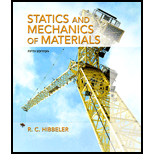
Concept explainers
What is the weight in newtons of an object that has a mass of (a) 8 kg, (b) 0.04 kg, (c) 760 Mg?
(a)
Convert the weight in newton of an object that has a mass in
Answer to Problem 1P
The weight in newton of an object that has a mass of
Explanation of Solution
The mass of the object is
Write the conversion for the quantity.
Write the conversion formula.
Convert the weight in newton from
Thus, the weight in newtons of an object is
(b)
Convert the weight in newton of an object that has a mass in
Answer to Problem 1P
The weight in newton of an object that has a mass of
Explanation of Solution
The mass of the object is
Write the conversion for the quantity.
Write the conversion formula.
Convert the weight in newton from
Thus, the weight in newtons of an object is
(c)
Convert the weight in newton of an object that has a mass in
Answer to Problem 1P
The weight in newtons of an object that has a mass of
Explanation of Solution
The mass of the object is
Write the conversion for the quantity.
Write the conversion formula.
Convert the weight in newton from
Thus, the weight in newtons of an object is
Want to see more full solutions like this?
Chapter 1 Solutions
Statics and Mechanics of Materials (5th Edition)
Additional Engineering Textbook Solutions
Automotive Technology: Principles, Diagnosis, And Service (6th Edition) (halderman Automotive Series)
Electric Circuits. (11th Edition)
Fluid Mechanics: Fundamentals and Applications
Concepts Of Programming Languages
Thermodynamics: An Engineering Approach
Problem Solving with C++ (10th Edition)
- What is the difference between saturated liquid and compressed liquid? What is the difference between the critical point and the triple pointarrow_forwardWhat is quality? Does it have any meaning in the superheated vapour region? What is the difference between saturated vapor and superheated vapour? What is the difference between saturated liquid and compressed liquid? What is the difference between the critical point and the triple point?arrow_forwardHomework#5arrow_forward
- Describe the principle operation of PEMFC, and role of membrane electrode assembly (MEA).arrow_forwardHomework#5arrow_forwardUsing graphical methods, draw the pressure angle at the position shown in (a) and (b). e |------- R = Cam Base Radius e = Follower Offset ẞ₁ = Section Duration 1 B₁ = Section Duration 2 ẞ₂ = Section Duration 3 В2 B₁ Follower Position ww R ẞ3 (a) Reference Radial (b)arrow_forward
- The figure below illustrates a graph that has a variable load torque and constant drive torque. Each cycle lasts three revolutions (6л radians). Torque (N-m) 600 550 400 1 200 TD= 225 N-m 2 + -T₁ 3 4 1 + 0 In addition, the rotation speed is @o steady-state conditions, determine 1. the average power required, 2πT 4π 5πT 6п Ꮎ = 180° rpm = 18.85 rad/sec, Imachine 125 kg-m². Assuming 2. the maximum and minimum rotational speeds throughout a cycle, 3. the mass of a 0.6-meter-diameter solid disc flywheel to produce Cs = 0.025.arrow_forwardAn elastic cord is stretched between 2 points A and B located 2y = 0.8 m apart in the horizontal plane. When stretched directly between A and B, the tension is P₂ = 40 N. The cord is then stretched as shown until its midpoint C has moved through x = 0.3 m to C', and a force of F = 240 N is required to hold the cord at C'. A pellet (m = 0.1 kg) is placed at C' and the cord is released. Find the speed of the pellet as it passes through C.arrow_forwardA 6305 ball bearing is subjected to a steady 5000-N radial load and a 2000-N thrust load and uses a very clean lubricant throughout its life. If the inner race angular velocity is 500rpm find (a) The equivalent radial load (b) The L10 life (c) The L50 lifearrow_forward
- Slove this the question plearrow_forwardDetermine the Mean Effective Pressure (MEP) in [bar] for a 4-cylinder, 2-Stroke engine with a bore of 85.7 mm, and a stroke of 65.8 mm, that produces 85 hP at 5000 rpm. (Hint: Be careful with units). Note: 1 hP = 0.7457 kW; 100 kPa = 1 bararrow_forwardIbraheem Super Q3: A boiler as shown in the figure below is producing 2 kg/s saturated steam at 240C. The water enters the boiler at 24C. The boiler efficiency is 80%. Patm=1.05 bar .Determine: (10 Marks) 1- The inlet pressure of the turbine. 2- If a gauge pressure connected to the outlet pipe, what is the reading of this gauge? 3- Calculate the required diesel in [kg/s]. Assume the calorific value of the diesel is 45000 kJ/kgf 4- Calculate the equivalent evaporation of the boiler 5- Keeping the same inlet conditions and fuel consumption, determine the turbine efficiency if the produced steam was saturated at 300C. Steam Cut Hot Gasses Out Ts=240C Boiler FURNACE A Water In C 24 Examiner Head of Department Ahmad. A. M. Alsak laniarrow_forward
 Refrigeration and Air Conditioning Technology (Mi...Mechanical EngineeringISBN:9781305578296Author:John Tomczyk, Eugene Silberstein, Bill Whitman, Bill JohnsonPublisher:Cengage Learning
Refrigeration and Air Conditioning Technology (Mi...Mechanical EngineeringISBN:9781305578296Author:John Tomczyk, Eugene Silberstein, Bill Whitman, Bill JohnsonPublisher:Cengage Learning
